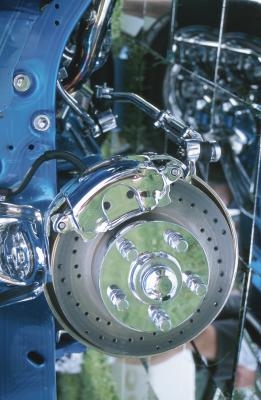
The calipers on a vehicle are pneumatic pistons that engage your brakes. The pressure created by depressing the brake pedal compresses the fluid forcing the calipers to engage. A problem with the calipers translates to reduced or no stopping power for the vehicle. Identifying a damaged caliper requires a visual inspection of the elements. Calipers operate in similar manners regardless of the make or model of your vehicle.
Look at the caliper with the wheels removed. Look at the back side of the rotor, the bleed screw and the hydraulic line connections. Any sign of fluid on the rotor or inside disc would imply a damaged dust boot or piston seal. Leaks around the bleed screw and hydraulic line connections are obvious and easy to replace. Cracks on the caliper housing will allow fluid to escape and requires replacement.
Ask someone to depress the brake pedal and spin the rotor. Spinning the rotor with ease or grinding indicates that the system has air in the line or the piston is frozen in place. Excessive heat from worn pads can fuse the piston to the caliper. A C-clamp can often free up the piston. Remove the brake shoes and look at the inner aspect of the pistons. Look for signs of damage, such as cracks in the base or scratch marks at the tips.
Pulling to one side while engaging the brakes indicates that one wheel is gripping better than the other. Bleeding the system will typically correct this. If the issue continues, the caliper is failing to engage the brake, which usually means a bad seal. Bleeding your brakes with any form of frequency indicates that air is pulling into the system from either the hydraulic lines or caliper. Leaks are not always obvious. Brakes locking up when engaging them or remaining locked also indicates caliper malfunction.